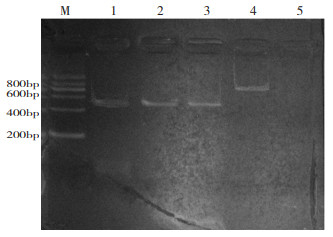-
摘要:
目的 研究黑色素瘤特异性抗原(preferentially expressed antigen of melanoma,PRAME)基因在急性白血病中的表达及其临床意义。 方法 应用逆转录-聚合酶链反应(RT-PCR)技术,检测自2009年5月到2010年5月收治的34例急性白血病患者和12例健康者骨髓单核细胞中PRAME基因的mRNA表达水平,并与患者临床资料行相关性分析。 结果 34例急性白血病患者中,PRAME基因表达率为38.2%(13/34),AML患者PRAME的阳性表达率为40.7%(11/27),ALL患者的阳性表达率为28.6%(2/ 7)。在AML各亚型中,M3型阳性率最高为80%,其次为M2(33.3%)和M5(28.6%)。分别行PRAME基因阳性与阴性组细胞表面抗原的监测,两组CD15(P < 0.05)及CD33(P < 0.05)的表达率均有显著性差异。染色体核型异常患者PRAME阳性率为61.5%(8/ 13),明显高于染色体核型正常者28.6%(4/14)(P < 0.05);患者的年龄、性别、白细胞数、骨髓中原始和幼稚细胞比例与PRAME基因mRNA的表达差异无统计学意义。 结论 PRAME基因在急性白血病中表达率较高,可作为监测微小残留病(minimal residual disease,MRD)的标志基因之一。PRAME有可能作为白血病特异性免疫治疗的靶抗原。 Abstract:Objective To investigate the expression of the preferentially expressed antigen of melanoma (PRAME) gene in acute leukemia and its clinical significance. Methods The mRNA expression of the PRAME gene in bone marrow mononuclear cells was measured via reverse transcriptase polymerase chain reaction in 34 acute leukemia (AL) patients (admitted between May 2009 and May 2010) and 12 bone marrow samples from healthy donors. The correlation between the expression of PRAME and the clinical characteristics of leukemia patients was analyzed. Results The PRAME gene was expressed in 38.2% of 34 patients (13/34), 40.7% (11/27) of acute myeloid leukemia (AML) patients, and 28.6% (2/7) of acute lymphoblastic leukemia (ALL) patients, but not in the healthy donors. The expressive difference between AML and ALL patients had statistical significance. The gene expression was in 80% M3, 33.3% M2, and 28.6% M5. The expression was also correlated with CD15 and CD33 expression and abnormal karyotype (8/13), but not with age, gender, white blood count, or blast percentage. Conclusion The PRAME gene is highly expressed of acute leukemia, and could be a useful parameter for monitoring MRD. It is a potential target for immunotherapy of acute leukemia. -
表 1 PRAME表达阳性的ALL患者一般情况
Table 1. Expression of PRAME in ALL patients

表 2 PRAME基因表达与CD15的关系
%(x±s) Table 2. Relationship between PRAME gene expression and CD15

表 3 PRAME基因表达与CD33的关系
%(x±s) Table 3. Relationship between PRAME gene expression and CD33

表 4 PRAME基因表达与染色体核型异常的关系
例 Table 4. Relationship between PRAME gene expression and karyotypic abnormality

-
[1] Ikeda H, Lethé B, Lehmann F, et al. Characterization of an antigen that is recognized on a melanoma showing partial HLA loss CTL expressing an NK inhibitory receptor[J]. Immunity, 1997, 6(2): 199-208. doi: 10.1016/S1074-7613(00)80426-4 [2] Matsushita M, Ikeda H, Kizaid M, et al, Quantitative monitoring of the PRAME gene for the detection of minimal residual disease in leukemia[J]. Br J haematol, 2001, 112(4): 916-926. doi: 10.1046/j.1365-2141.2001.02670.x [3] Gure AO, Stockert E, Arden KC, et al. CT10: a new cancer-testis(CT) antigen homologous to CT17 and the MAGE family, identified by representational-difference analysis[J]. Int J Cancer, 2000, 85(5): 726-732. doi: 10.1002/(SICI)1097-0215(20000301)85:5<726::AID-IJC21>3.0.CO;2-F [4] Paydas R, Tanriverdi K, Yavuz S, et al. PRAME mRNA Levels in cases with acute leukemia: clinical importance and future prospects [J]. Am J Hematol, 2005, 79(4): 257-261. doi: 10.1002/ajh.20425 [5] van Baren N, Chambost H, Ferrant A, et al. PRAME, a gene encoding an antigen recognized on a human melanoma by cytolytic T cells is expressed in acute leukaemica cells[J]. Br J Haematol, 1998, 102(5): 1376-1379. doi: 10.1046/j.1365-2141.1998.00982.x [6] Steinbach D, Hemann J, Viehmann S, et al. Clinical implications of PRAME gene expression in childhood acute myeloid leukemia[J]. Cancer Genet Cytogenet, 2002, 133(2): 118-123. doi: 10.1016/S0165-4608(01)00570-2 [7] Pin Y, Zhu H, Jiang B, et al. Expression patterns of WT1 and PRAME in acute myeloid Leukemia patients and their usefulness for monitoring minimal residual disease[J]. Leuk Res, 2009, 33(3): 384-390. doi: 10.1016/j.leukres.2008.08.026 [8] 徐凯红, 杨刚毅, 黄宗干, 等. 白血病患者PRAME基因的表达及其与WT1基因比较的临床意义[J]. 临床血液学杂志, 2002, 16(3): 113-115. https://www.cnki.com.cn/Article/CJFDTOTAL-LCXZ200303006.htm [9] Oehler VG, Guthrie KA, Cummings CL, et al. The preferentially expressed antigen in melanoma (PRAME) inhibits myeloid differentiation in normal hematopoietic and leukemic progenitor cells[J]. Blood, 2009, 114(15): 3299-3308. doi: 10.1182/blood-2008-07-170282 [10] Costessi A, Mahrour N, Tijchon E, et al. The tumor antigen PRAME is a subunit of a Cul2 ubiquitin ligase and associates with active NFY promoters[J]. EMBO J, 2011, 30(18): 3786-3798. doi: 10.1038/emboj.2011.262 [11] Oehler VG, Guthrie KA, Cummings CL, et al. The preferentially expressed antigen in melanoma (PRAME) inhibits myeloid differentiation in normal hematopoietic and leukemic progenitor cells[J]. Blood, 2009, 114(15): 3299-3308. doi: 10.1182/blood-2008-07-170282 [12] Rezvani K, Yong AS, Tawab A, et al. Ex vivo characterization of polyclonal memory CD8 + T-cell responses to PRAME-specific peptides in patients with acute lymphoblastic leukemia and acute and chronic myeloid leukemia[J]. Blood. 2009, 113(10): 2245-2255. doi: 10.1182/blood-2008-03-144071 -




 下载:
下载:


